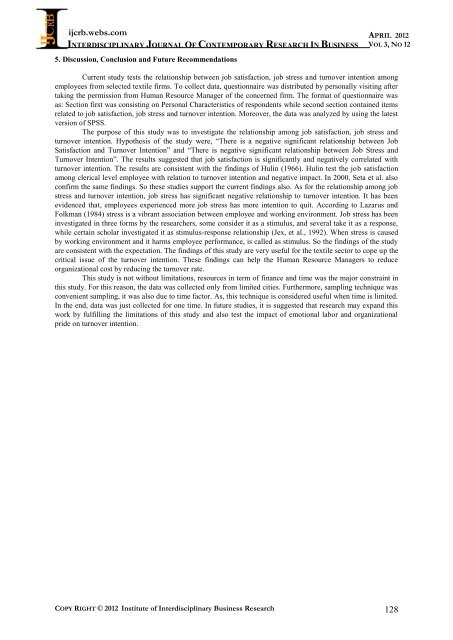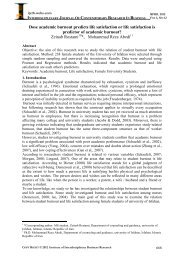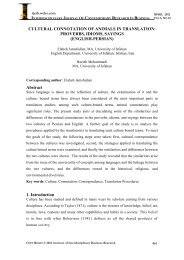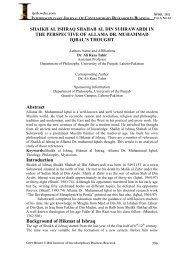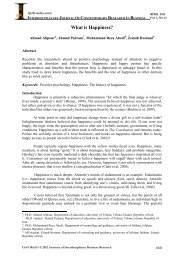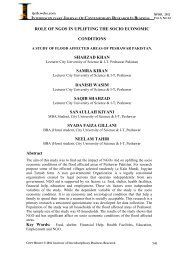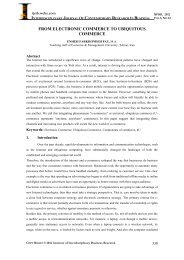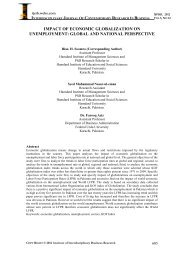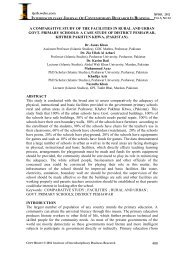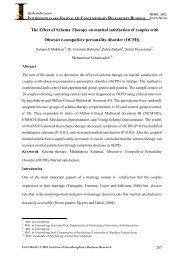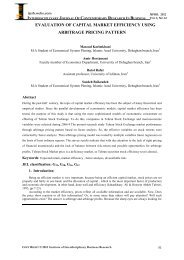Turnover Intention: An HRM Issue in Textile Sector - journal ...
Turnover Intention: An HRM Issue in Textile Sector - journal ...
Turnover Intention: An HRM Issue in Textile Sector - journal ...
Create successful ePaper yourself
Turn your PDF publications into a flip-book with our unique Google optimized e-Paper software.
ijcrb.webs.com<br />
INTERDISCIPLINARY JOURNAL OF CONTEMPORARY RESEARCH IN BUSINESS<br />
5. Discussion, Conclusion and Future Recommendations<br />
APRIL 2012<br />
VOL 3, NO 12<br />
Current study tests the relationship between job satisfaction, job stress and turnover <strong>in</strong>tention among<br />
employees from selected textile firms. To collect data, questionnaire was distributed by personally visit<strong>in</strong>g after<br />
tak<strong>in</strong>g the permission from Human Resource Manager of the concerned firm. The format of questionnaire was<br />
as: Section first was consist<strong>in</strong>g on Personal Characteristics of respondents while second section conta<strong>in</strong>ed items<br />
related to job satisfaction, job stress and turnover <strong>in</strong>tention. Moreover, the data was analyzed by us<strong>in</strong>g the latest<br />
version of SPSS.<br />
The purpose of this study was to <strong>in</strong>vestigate the relationship among job satisfaction, job stress and<br />
turnover <strong>in</strong>tention. Hypothesis of the study were, “There is a negative significant relationship between Job<br />
Satisfaction and <strong>Turnover</strong> <strong>Intention</strong>” and “There is negative significant relationship between Job Stress and<br />
<strong>Turnover</strong> <strong>Intention</strong>”. The results suggested that job satisfaction is significantly and negatively correlated with<br />
turnover <strong>in</strong>tention. The results are consistent with the f<strong>in</strong>d<strong>in</strong>gs of Hul<strong>in</strong> (1966). Hul<strong>in</strong> test the job satisfaction<br />
among clerical level employee with relation to turnover <strong>in</strong>tention and negative impact. In 2000, Seta et al. also<br />
confirm the same f<strong>in</strong>d<strong>in</strong>gs. So these studies support the current f<strong>in</strong>d<strong>in</strong>gs also. As for the relationship among job<br />
stress and turnover <strong>in</strong>tention, job stress has significant negative relationship to turnover <strong>in</strong>tention. It has been<br />
evidenced that, employees experienced more job stress has more <strong>in</strong>tention to quit. Accord<strong>in</strong>g to Lazarus and<br />
Folkman (1984) stress is a vibrant association between employee and work<strong>in</strong>g environment. Job stress has been<br />
<strong>in</strong>vestigated <strong>in</strong> three forms by the researchers, some consider it as a stimulus, and several take it as a response,<br />
while certa<strong>in</strong> scholar <strong>in</strong>vestigated it as stimulus-response relationship (Jex, et al., 1992). When stress is caused<br />
by work<strong>in</strong>g environment and it harms employee performance, is called as stimulus. So the f<strong>in</strong>d<strong>in</strong>gs of the study<br />
are consistent with the expectation. The f<strong>in</strong>d<strong>in</strong>gs of this study are very useful for the textile sector to cope up the<br />
critical issue of the turnover <strong>in</strong>tention. These f<strong>in</strong>d<strong>in</strong>gs can help the Human Resource Managers to reduce<br />
organizational cost by reduc<strong>in</strong>g the turnover rate.<br />
This study is not without limitations, resources <strong>in</strong> term of f<strong>in</strong>ance and time was the major constra<strong>in</strong>t <strong>in</strong><br />
this study. For this reason, the data was collected only from limited cities. Furthermore, sampl<strong>in</strong>g technique was<br />
convenient sampl<strong>in</strong>g, it was also due to time factor. As, this technique is considered useful when time is limited.<br />
In the end, data was just collected for one time. In future studies, it is suggested that research may expand this<br />
work by fulfill<strong>in</strong>g the limitations of this study and also test the impact of emotional labor and organizational<br />
pride on turnover <strong>in</strong>tention.<br />
COPY RIGHT © 2012 Institute of Interdiscipl<strong>in</strong>ary Bus<strong>in</strong>ess Research 128


